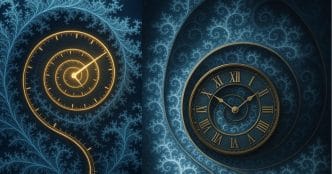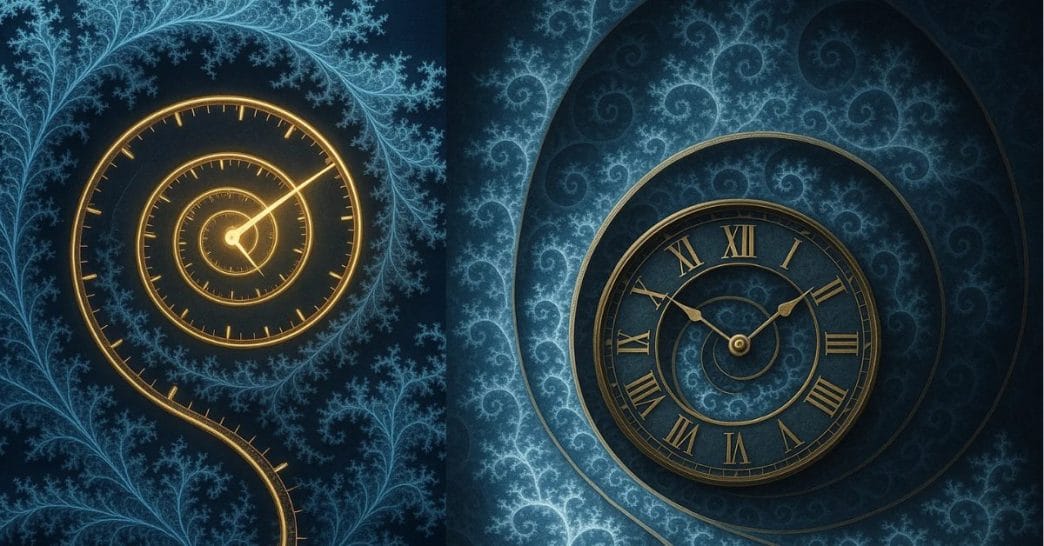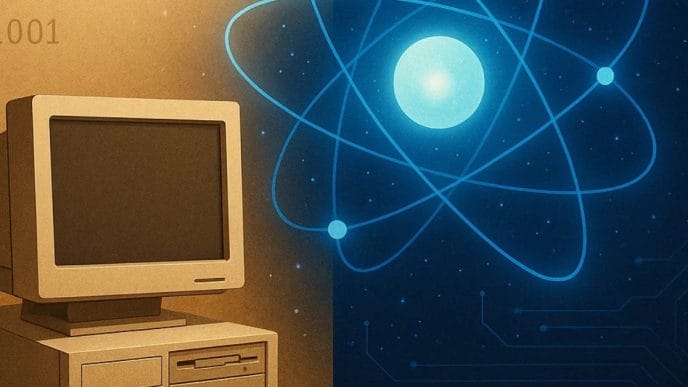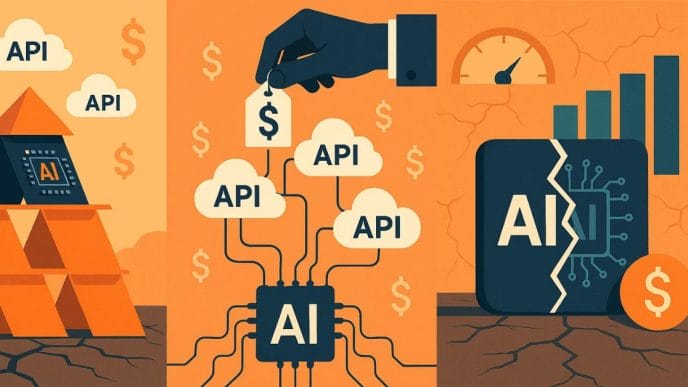Time isn’t just a straight arrow ticking from past to future. What if it curls, folds, and repeats like patterns inside a snowflake? Fractal Time suggests exactly that: cycles within cycles, events echoing across scales from microseconds to millennia. Just as a coastline looks jagged whether seen from a plane or up close, history, physics, and even our thoughts might be running on recursive rhythms.
Think of seasons: inside a year, we find nested months, weeks, days, hours. Finance charts show the same chaos at yearly and minute scales. Galaxies spin, civilizations rise and fall — each a zoomed-in replay of larger cycles.
From Chaos to Clarity: The Math Behind the Madness
The roots lie in chaos theory. In the 1960s, Edward Lorenz stumbled on the “butterfly effect” — tiny tweaks that lead to monstrous outcomes. His equations, when iterated, produced attractors: shapes that never repeated exactly but carried echoes of themselves at every scale. That’s the fractal fingerprint of time.
Enter Benoit Mandelbrot, the man who gave us fractal geometry. He showed us how clouds, rivers, and markets could all be mapped not with neat lines, but with recursive, infinite roughness. Later, physicist Laurent Nottale suggested even spacetime itself might be fractal — zoom in far enough, and the fabric of the universe could look like Mandelbrot’s set.
On the fringes, Terence McKenna popularized the “Timewave Zero” idea — that history itself is a recursive wave marching toward singularity-like tipping points. Critics scoffed, but his intuition captured the cultural imagination.
Science Speaks: Echoes in Physics and Biology
Where does this leap from metaphor to measurement?
- Physics: radioactive decay intervals, earthquake timings, and quantum jumps all hint at fractal distributions. Even galaxies cluster fractally in cosmic surveys.
- Biology & neuroscience: heartbeats, sleep cycles, and brain waves display fractal scaling. Your neurons fire in rhythms nested like Russian dolls.
- Nonlinear dynamics: weather, population growth, and ecosystems don’t follow straight lines — they’re recursive feedback machines.
The Newtonian view of time as a universal clock has long cracked. Einstein bent it with relativity. Fractal time suggests it doesn’t just bend — it branches.
Tech’s New Toy: Fractal Time in AI & Analytics
Why does Wall Street care about fractals? Because price charts look like Mandelbrot doodles. Fractal finance replaced the naïve idea of random walks with clustered volatility. Traders now use fractal models to sniff out hidden order in the chaos of markets.
AI researchers, too, are in love. Deep learning models trained on time series data — from consumer trends to climate patterns — are better forecasters when they account for fractal correlations. Imagine algorithms that don’t just “look ahead,” but sense the recursive pulse of history.
Neuroscience joins the party: EEG scans show fractal activity in brain waves. Your experience of time itself may be coded fractally, explaining why five minutes can feel like forever, or hours vanish in a flow state.
Ancient Whispers: Yugas, Kalpas, and Mayan Codes
Long before chaos theorists, civilizations whispered of time as a wheel.
- Mayan Calendar: baktuns within katuns within tuns — cycles nested like gears inside gears.
- Hindu Yugas: cosmic epochs that reset in repeating moral and spiritual arcs.
- Buddhist Kalpas: eons of creation and dissolution, recursive by design.
Even modern historians like Arnold Toynbee saw civilizations rising and collapsing in fractal waves. And futurist Ray Kurzweil argues technology accelerates in nested cycles — the doubling of computing power is just one echo in the grand recursion.
From ancient chants to Silicon Valley slideshows, the story is the same: time isn’t a line, it’s a remix.
The Fractal Future: Breakthroughs or Beautiful Illusions?
Here’s the tantalizing part. What if fractal time could:
- Give AGI the ability to “intuit” patterns across history and predict societal tipping points?
- Provide cosmology a new way to unify quantum weirdness with Einstein’s relativity?
- Offer policymakers early warnings of collapses, revolutions, or climate shocks?
But skeptics warn: humans are pattern-hungry. We see faces in clouds and cycles in chaos. Is fractal time a profound law, or just mathematical pareidolia? The jury is still out.
Whether hard science or metaphor, fractal time changes how we feel the moment. Each choice may echo at scales we can’t see. Each collapse may be just another curve in a bigger cycle.
Maybe we don’t live in a straight arrow of history, but in a spiraling staircase — forever climbing, forever circling back.
Fractal Time isn’t just about clocks and calendars — it’s about realizing that everything we build, break, and dream might just be an echo in the infinite loop of existence.















